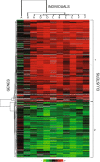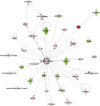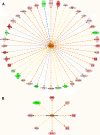The early phase transcriptome of bovine monocyte-derived macrophages infected with Staphylococcus aureus in vitro
- PMID: 24341851
- PMCID: PMC3878444
- DOI: 10.1186/1471-2164-14-891
The early phase transcriptome of bovine monocyte-derived macrophages infected with Staphylococcus aureus in vitro
Abstract
Background: In the mammary gland, local recruitment and action of macrophages is a key immunological defence mechanism against infection. Macrophages are members of the innate immune system, serve as the first line of the defence against invading pathogens and are critical effectors and regulators of inflammation. We have examined the early phase response of bovine macrophages to infection with live Staphylococcus aureus. Genome-wide transcript profiling of blood monocyte-derived macrophages from six Norwegian Red heifers infected with live S. aureus for 2 and 6 hours in vitro was performed.
Results: About 420 of the 17 000 genes on the ARK-Genomics bovine cDNA array were differentially regulated at 6 hours post infection. Approximately 70% of the responding genes had a known identity (Entrez Gene ID) and were used in the identification of overrepresented pathways and biological functions in the dataset.Analysis of a subset of differentially regulated genes (List eQG) obtained by comparison with data from genome-wide association mapping in Norwegian Red cattle identified anti-inflammatory cytokines interleukin 4 and interleukin 13 as putative expression quantitative trait loci, suggesting that S. aureus infection triggers alternative activation of macrophages. Moreover, several classical activation pathways were found, mainly cellular immune response and cytokine signaling pathways, i.e. triggering receptor expressed on myeloid cells 1 (TREM1) and nucleotide-binding and oligomerization domain-like receptor (NLR) pathways. Tumor necrosis factor receptor superfamily member 5 (CD40 ligand) was identified as an upstream regulator which points toward CD40 likely acting as a co-stimulatory receptor during Toll-like receptor 2(TLR2)-mediated inflammatory response of bovine macrophages to S. aureus infection. Furthermore, peptidoglycan was identified as an upstream regulator in the List eQG, which indicates that this bacterial cell-wall component might be pivotal in macrophage intracellular bacterial recognition during early inflammation.
Conclusions: Here we have shown that in vitro infection of bovine macrophages with live S. aureus induced both alternative and classical activation pathways. Alternative activation of macrophages may be a mechanism contributing to intracellular persistence of S. aureus in the course of inflammation such as during mastitis in dairy cattle.
Figures






Similar articles
-
Differentiating Staphylococcus aureus from Escherichia coli mastitis: S. aureus triggers unbalanced immune-dampening and host cell invasion immediately after udder infection.Sci Rep. 2017 Jul 6;7(1):4811. doi: 10.1038/s41598-017-05107-4. Sci Rep. 2017. PMID: 28684793 Free PMC article.
-
Hepatic Transcriptome Analysis Identifies Divergent Pathogen-Specific Targeting-Strategies to Modulate the Innate Immune System in Response to Intramammary Infection.Front Immunol. 2020 Apr 29;11:715. doi: 10.3389/fimmu.2020.00715. eCollection 2020. Front Immunol. 2020. PMID: 32411137 Free PMC article.
-
Gene expression profiling of bovine mammary gland epithelial cells stimulated with lipoteichoic acid plus peptidoglycan from Staphylococcus aureus.Int Immunopharmacol. 2014 Jul;21(1):231-40. doi: 10.1016/j.intimp.2014.05.002. Epub 2014 May 14. Int Immunopharmacol. 2014. PMID: 24836680
-
Forkhead Box O1 Regulates Macrophage Polarization Following Staphylococcus aureus Infection: Experimental Murine Data and Review of the Literature.Clin Rev Allergy Immunol. 2016 Dec;51(3):353-369. doi: 10.1007/s12016-016-8531-1. Clin Rev Allergy Immunol. 2016. PMID: 26924010 Review.
-
Recognition of Staphylococcus aureus by the innate immune system.Clin Microbiol Rev. 2005 Jul;18(3):521-40. doi: 10.1128/CMR.18.3.521-540.2005. Clin Microbiol Rev. 2005. PMID: 16020688 Free PMC article. Review.
Cited by
-
Transcription Profiling of Monocyte-Derived Macrophages Infected In Vitro With Two Strains of Streptococcus agalactiae Reveals Candidate Pathways Affecting Subclinical Mastitis in Cattle.Front Genet. 2019 Jul 26;10:689. doi: 10.3389/fgene.2019.00689. eCollection 2019. Front Genet. 2019. PMID: 31417606 Free PMC article.
-
The secretomes of bovine mammary epithelial cell subpopulations differentially modulate macrophage function.Vet Q. 2025 Dec;45(1):1-14. doi: 10.1080/01652176.2025.2463338. Epub 2025 Feb 8. Vet Q. 2025. PMID: 39921381 Free PMC article.
-
New Insights on Nucleotide Sequence Variants and mRNA Levels of Candidate Genes Assessing Resistance/Susceptibility to Mastitis in Holstein and Montbéliarde Dairy Cows.Vet Sci. 2023 Jan 3;10(1):35. doi: 10.3390/vetsci10010035. Vet Sci. 2023. PMID: 36669036 Free PMC article.
-
DNA methylation rather than single nucleotide polymorphisms regulates the production of an aberrant splice variant of IL6R in mastitic cows.Cell Stress Chaperones. 2018 Jul;23(4):617-628. doi: 10.1007/s12192-017-0871-0. Epub 2018 Jan 20. Cell Stress Chaperones. 2018. PMID: 29353404 Free PMC article.
-
Comparative virulence studies and transcriptome analysis of Staphylococcus aureus strains isolated from animals.Sci Rep. 2016 Oct 14;6:35442. doi: 10.1038/srep35442. Sci Rep. 2016. PMID: 27739497 Free PMC article.
References
Publication types
MeSH terms
LinkOut - more resources
Full Text Sources
Other Literature Sources
Medical
Research Materials

